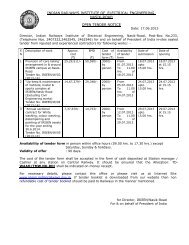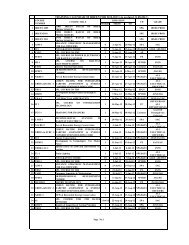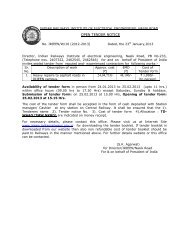remote control equipment - Indian Railways Institute of Electrical ...
remote control equipment - Indian Railways Institute of Electrical ...
remote control equipment - Indian Railways Institute of Electrical ...
You also want an ePaper? Increase the reach of your titles
YUMPU automatically turns print PDFs into web optimized ePapers that Google loves.
It is seen that even if the lines are within 10 metre <strong>of</strong> contact wire they are subjected to<br />
induced voltages exceeding 1000. This would lead to a continuous discharge across the spark<br />
gaps with which telephone circuits are normally equipped and which have a nominal break<br />
down voltage <strong>of</strong> about 100V dc.<br />
When such bare conductors situated in the electric field are earthed through a person’s body<br />
the resulting discharge current is proportional to the inducing voltage and the capacitance or<br />
length <strong>of</strong> parallelism. If the parallelism reaches around 10 km the current could reach<br />
dangerous proportions. Hence, it is not possible to contemplate normal operation <strong>of</strong> circuits<br />
with bare overhead conductors over any significant length alongside an ac electrified railway.<br />
Electrostatic effects decrease very rapidly when the separation between the inducing line and<br />
the line receiving induced emf is increased. If separation is increased to 40m the voltage in<br />
conductors placed parallel to 25 kV contact wire hardly exceeds 150V rms and the drawback<br />
<strong>of</strong> continuous discharge across the spark gaps is immediately removed.<br />
The CCITT gives the following formula (which is more conservative than the one cited above)<br />
to arrive at the minimum separation between contact wire and the communication line to limit<br />
the induced voltage to 300 Volts. The minimum spacing is given by<br />
a = 1/3 E<br />
Where E is the contact wire voltage. For 25 kV system this works out to 53 m.<br />
In order to calculate electric induction due to an oblique exposure the distance a is replaced<br />
by the geometrical mean a1a2 between the distances at the ends in the formula.<br />
The calculation takes into account ideal conditions i.e lines parallel to earth’s surface and<br />
mostly to one another, free from additional capacitances and pure sinusoidal alternating<br />
current. In practice these conditions are never fulfilled. Line sags reduces average height and<br />
additional capacitances occur between wires and poles including capacitance <strong>of</strong> insulators.<br />
Further, roughness <strong>of</strong> earth’s surface, vegetation, buildings, etc. result in reducing the effective<br />
height <strong>of</strong> conductors. The combined effect <strong>of</strong> all these is to increase capacitances to earth by<br />
20% and mutual capacitances between conductors get reduced. Hence, measured values <strong>of</strong><br />
electric induced open circuit voltages are usually smaller than the calculated values. However,<br />
high harmonics, even with a small amplitude may increase considerably, the electric induced<br />
short circuit current.<br />
146
















